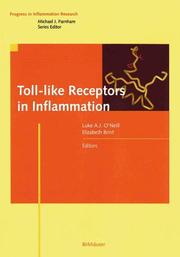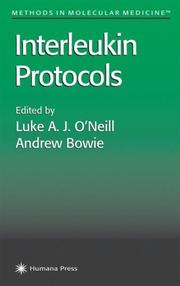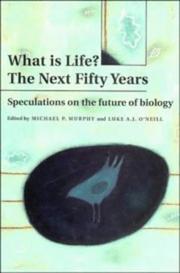| Listing 1 - 7 of 7 |
Sort by
|

ISBN: 1280608846 9786610608843 3764374411 3764372850 Year: 2005 Publisher: Basel ; Boston : Birkhauser Verlag,
Abstract | Keywords | Export | Availability | Bookmark
 Loading...
Loading...Choose an application
- Reference Manager
- EndNote
- RefWorks (Direct export to RefWorks)
Toll-like receptors (TLRs) are critical mediators of the innate immune response in mammals. This family of receptors recognizes a variety of microbial products or motifs and initiates the host response to infection. Examples include TLR4 which recognizes lipopolysaccharide (LPS) from Gram-negative bacteria, TLR3 which recognizes viral double-stranded RNA, and TLR9 which recognizes CpG DNA motifs, found in both viruses and bacteria. All TLRs possess an intracellular region termed the Toll-IL-1 receptor-Resistance (TIR) domain which is essential for signaling from these receptors. The specificity of signaling from individual TLRs arises from differential utilization of adapter proteins. This specificity results in a tailoring of the host defense response depending on the microbe being sensed. TLRs are increasingly being implicated in both infectious and inflammatory diseases, notable examples being sepsis, inflammatory bowel disease, atherosclerosis, and asthma. There is, therefore, great interest in targeting TLRs therapeutically since a disruption of TLR function will result in a decrease in the production of inflammatory mediators. This volume covers our current understanding of TLRs and their role in inflammation. Given the importance of TLRs in the inflammatory process and their emerging role in inflammatory diseases the book is of great interest to researchers working in inflammation and immunology.
Inflammation --- Cell receptors. --- Mediators. --- Immunological aspects. --- Cell membrane receptors --- Cell surface receptors --- Receptors, Cell --- Binding sites (Biochemistry) --- Cell membranes --- Proteins --- Immunology of inflammation --- Immune response --- Inflammatory mediators --- Mediators of inflammation --- Biomolecules --- Immunology --- Immunology. --- Emerging infectious diseases. --- Microbiology. --- Cytology. --- Toxicology. --- Infectious Diseases. --- Medical Microbiology. --- Cell Biology. --- Pharmacology/Toxicology. --- Chemicals --- Medicine --- Pharmacology --- Poisoning --- Poisons --- Cell biology --- Cellular biology --- Biology --- Cells --- Cytologists --- Microbial biology --- Microorganisms --- Emerging infections --- New infectious diseases --- Re-emerging infectious diseases --- Reemerging infectious diseases --- Communicable diseases --- Immunobiology --- Life sciences --- Serology --- Toxicology --- Infectious diseases. --- Medical microbiology. --- Cell biology. --- Pharmacology. --- Drug effects --- Medical pharmacology --- Medical sciences --- Chemotherapy --- Drugs --- Pharmacy --- Physiological effect

ISBN: 1280821116 9786610821112 1592591469 089603738X Year: 2001 Publisher: Totowa, NJ : Humana Press : Imprint: Humana,
Abstract | Keywords | Export | Availability | Bookmark
 Loading...
Loading...Choose an application
- Reference Manager
- EndNote
- RefWorks (Direct export to RefWorks)
Interleukins, a family of proteins that regulate immunity and inflammation throughout the body, are also involved in autoimmune disease (rheumatoid arthritis, multiple sclerosis, and asthma); are implicated in such other conditions as cancer, myocardial infarction, and depression; and have value in the diagnosis and prognosis of many diseases. Luke O'Neill and Andrew Bowie bring together in Interleukin Protocols a collection of standard and advanced methods for measuring these powerful agents. Their readily reproducible techniques range from the assay of interleukin protein and mRNA-using ELISA, FACS, and RT-PCR-to the study of interleukin signal transduction. Newer techniques are also covered, including the analysis of interleukin gene polymorphisms and the use of cDNA microarrays. Many of the assays are geared to specific pathologies, including breast cancer, depression, psoriasis, Grave's disease, migraine, and myocardial infarction. There are also helpful discussions of the difficulties in measuring interleukins in different biological fluids, such as sputum from asthma patients, peritoneal fluids, synovial fluid from arthritic joints, and cerbrospinal fluid from patients with meningitis. Each step-by-step method is described by a hands-on expert and includes notes on how to avoid failure. Comprehensive and highly practical, Interleukin Protocols offers biomedical investigators a stellar collection of all the major techniques needed to analyze the role of interleukins in disease, to improve diagnosis, and to foster the rapid emergence of new and more powerful therapeutics.
Immunology. --- Immunobiology --- Life sciences --- Serology
Digital
ISBN: 9783764374419 Year: 2005 Publisher: Basel Birkhäuser Verlag
Abstract | Keywords | Export | Availability | Bookmark
 Loading...
Loading...Choose an application
- Reference Manager
- EndNote
- RefWorks (Direct export to RefWorks)
Histology. Cytology --- Immunology. Immunopathology --- Pharmacology. Therapy --- Medical microbiology, virology, parasitology --- Infectious diseases. Communicable diseases --- immunologie --- medische microbiologie --- farmacologie --- toxicologie --- besmettelijke ziekten --- cytologie --- histologie

ISBN: 052145509X 0521599393 9780521455091 9780521599399 9780511623295 Year: 1997 Publisher: Cambridge Cambridge University Press
Abstract | Keywords | Export | Availability | Bookmark
 Loading...
Loading...Choose an application
- Reference Manager
- EndNote
- RefWorks (Direct export to RefWorks)
Biology --- Life (Biology) --- Philosophy --- Congresses --- Schrodinger, Erwin --- Biologie --- biology --- Recherche --- research --- Changement technologique --- technological changes --- Ethics --- Patrimoine culturel --- Cultural heritage --- 573.7 --- -Biology --- -Life (Biology) --- -#WPLT:dd.prof.J.Vendrig --- Life sciences --- Biomass --- Natural history --- General properties and characteristics of living systems --- -Congresses --- Congresses. --- 573.7 General properties and characteristics of living systems --- -Congresses. --- #WPLT:dd.prof.J.Vendrig --- Philosophy&delete& --- Schrödinger, Erwin, --- Schrödinger, Erwin --- Biology - Philosophy - Congresses --- Biology - Congresses --- Life (Biology) - Congresses --- Schrodinger, Erwin - Congresses
Book
ISBN: 1597455415 193411572X Year: 2009 Publisher: Totowa, NJ : Humana Press : Imprint: Humana,
Abstract | Keywords | Export | Availability | Bookmark
 Loading...
Loading...Choose an application
- Reference Manager
- EndNote
- RefWorks (Direct export to RefWorks)
In addition to their invaluable role in the fight against infection, Toll-Like Receptors (TLRs) in an under- or over-active state can lead to the pathogenesis of disease, making these receptors a key focal point for many research laboratories. In Toll-Like Receptors: Methods and Protocols, experts in the field contribute techniques currently used to study TLRs, their downstream signalling pathways, and their role in the pathogenesis of disease, with sections examining TLR expression and the application of genetic techniques and microarray analysis to TLR research. Written in the highly successful Methods in Molecular Biology™ series format, chapters include brief introductions to the topics, lists of the necessary materials and reagents, step-by-step, readily reproducible laboratory protocols, and Notes sections highlighting tips on troubleshooting and avoiding known pitfalls. Versatile and cutting-edge, Toll-Like Receptors: Methods and Protocols provides an ideal manual for a wide range of biologists and medical researchers studying these vital components of the immune system.
Immunology. --- Cytokines. --- Cytokines and Growth Factors. --- Cellular immunity --- Immune response --- Immunobiology --- Life sciences --- Serology --- Regulation
Book
ISBN: 9783764374419 Year: 2005 Publisher: Basel Birkhäuser Verlag
Abstract | Keywords | Export | Availability | Bookmark
 Loading...
Loading...Choose an application
- Reference Manager
- EndNote
- RefWorks (Direct export to RefWorks)
Toll-like receptors (TLRs) are critical mediators of the innate immune response in mammals. This family of receptors recognizes a variety of microbial products or motifs and initiates the host response to infection. Examples include TLR4 which recognizes lipopolysaccharide (LPS) from Gram-negative bacteria, TLR3 which recognizes viral double-stranded RNA, and TLR9 which recognizes CpG DNA motifs, found in both viruses and bacteria. All TLRs possess an intracellular region termed the Toll-IL-1 receptor-Resistance (TIR) domain which is essential for signaling from these receptors. The specificity of signaling from individual TLRs arises from differential utilization of adapter proteins. This specificity results in a tailoring of the host defense response depending on the microbe being sensed. TLRs are increasingly being implicated in both infectious and inflammatory diseases, notable examples being sepsis, inflammatory bowel disease, atherosclerosis, and asthma. There is, therefore, great interest in targeting TLRs therapeutically since a disruption of TLR function will result in a decrease in the production of inflammatory mediators. This volume covers our current understanding of TLRs and their role in inflammation. Given the importance of TLRs in the inflammatory process and their emerging role in inflammatory diseases the book is of great interest to researchers working in inflammation and immunology.
Histology. Cytology --- Immunology. Immunopathology --- Pharmacology. Therapy --- Medical microbiology, virology, parasitology --- Infectious diseases. Communicable diseases --- immunologie --- medische microbiologie --- farmacologie --- toxicologie --- besmettelijke ziekten --- cytologie --- histologie
Book
ISBN: 0511623291 Year: 1995 Publisher: Cambridge : Cambridge University Press,
Abstract | Keywords | Export | Availability | Bookmark
 Loading...
Loading...Choose an application
- Reference Manager
- EndNote
- RefWorks (Direct export to RefWorks)
Erwin Schrödinger's book What is Life? had a tremendous influence on the development of molecular biology, stimulating scientists such as Watson and Crick to explore the physical basis of life. Much of the appeal of Schrödinger's book lay in its approach to the central problems in biology - heredity and how organisms use energy to maintain order - from a physicist's perspective. At Trinity College, Dublin a number of outstanding scientists from a range of disciplines gathered to celebrate the fiftieth anniversary of What is Life? and following Schrödinger's example fifty years previously, presented their views on the current central problems in biology. The contributors to this volume include Stephen Jay Gould, Roger Penrose, Jared Diamond, Manfred Eigen, John Maynard Smith, Christien de Duve and Lewis Wolpert. This collection is essential reading for anyone interested in biology and its future.
Biology --- Life (Biology) --- Philosophy --- Schrödinger, Erwin,
| Listing 1 - 7 of 7 |
Sort by
|

 Search
Search Feedback
Feedback About UniCat
About UniCat  Help
Help News
News